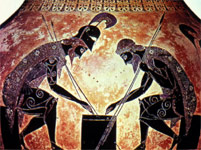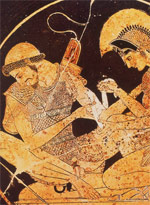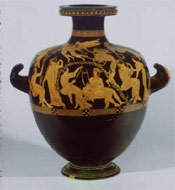Introduction
Greek vases: a short history

|

|

|
The beginning of Greek vase painting coincides with the composition of Homer’s epic poems. In this period we see the production of epic sized amphorai often over 5ft in height. Such vases appear prominently as grave markers and even as receptacles for deceased infants, providing a striking demonstration of wealth and power.
Consider the picture at right (enlarge). What do you notice about the way in which the vase is decorated? Click here for a summary of design elements...
The growth of trade and interactions with other Mediterranean peoples seems to have stimulated Greek artists. In particular, the richness of decoration on objects from the Near East was a particular source of inspiration. During the so-called Orientalising Period (c. mid-7th century BCE), artists began to replace the geometric designs with ones that contained narratives, as in the example to the right (fig. 2.2) by the Menelas Painter, which depicts the blinding of Polyphemus on the neck and Perseus’ encounter with the Gorgons between the handles.
What do you notice about the design? In what other ways does the painting on this vase differ from the geometric patterning of the Dipylon amphora?
Such vases, like the formulaic, geometric designs, were not intended for everyday use but as monumental markers.
Meanwhile a revolution was taking place not, as we might expect, at Athens, but at Corinth. There artists were working on a much smaller scale. They created designs in silhouette, a feature evident in the geometric style vase painting, but they enlivened them through the use of incision. This technique is known as ‘black figure’ painting. In the next two centuries this technique was adopted enthusiastically by Athenian painters. They combined the detail evident in the geometric style with a desire for epic narrative apparent in the orientalising period. This combination led to a flowering of artistic expression during the archaic period. Early black-figure vases retained the frieze style typical of the geometric period but filled the frieze (like later Greek temples) with elaborate scenes from myth and everyday life. It reached a climax with the François Vase of the painter Kleitias and Ergotimos the potter (c. 570 BCE).
Later black-figure vase painting did away with the need for friezes. The great Athenian painter, Exekias, related his paintings to the essential form of the vase, creating a coherent depiction which filled the intended space in a single panel. His designs indicate the height of Athenian black-figure painting where his scenes are executed with elaborate and exquisite detail. This is evident in the scene where Achilles and Ajax are playing a game (c. 540-530 BCE).

|

|
The daunting quality of Exekias’ work must have been a hard act to follow. Yet towards the end of the 6th century BCE, painters began to experiment with a new style. The so-called ‘red figure style’ used brush strokes rather than incision for its effects. The results were dramatic. The use of the brush rather than incision allowed much more freedom of expression, a flowing style, greater depth, with a suggestion of physical mass and three-dimensions.

|
In the century that followed, red-figure vase painting became the predominant style, although black-figure vases continued to be produced. Both styles had their merits, but the more successful painters worked in the red-figure technique because it allowed them to explore a greater range of feeling and expression. By the end of the 5th century BCE, the artistic realism apparent in architectural sculpture, as it appeared on the Parthenon, was apparent in Greek vases. Vases from the later period depict highly complex scenes with a variety of figures in different poses. The best artists created a sense of depth and movement as apparent from this vase by the Meidias Painter (c. 410 BCE).
Ubiquity of pottery < Previous | Next > Vase production